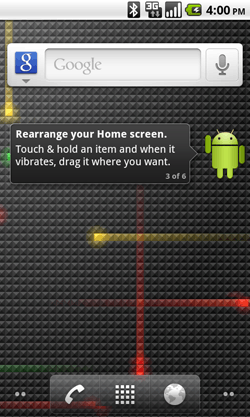Android Froyo
| A version of the Android operating system | |
|
| |
 Android 2.2.3 Home Screen | |
| Developer | |
|---|---|
| Initial release | May 20, 2010 |
| Latest release | 2.2.3 / November 21, 2011 |
| Preceded by | Android 2.1 "Eclair" |
| Succeeded by | Android 2.3 "Gingerbread" |
| Official website |
developer |
| Support status | |
| Obsolete, unsupported | |
Android "Froyo" is the sixth update of Android and is a codename of the Android mobile operating system developed by Google, spanning versions between 2.2 and 2.2.3.[1] Those versions are no longer supported. It was unveiled on May 20, 2010, during the Google I/O 2010 conference.
One of the most prominent changes in the Froyo release was USB tethering and Wi-Fi hotspot functionality.[2] Other changes include support for the Android Cloud to Device Messaging (C2DM) service, enabling push notifications, Additional application speed improvements, implemented through JIT compilation[3] and displayed within applications as top-of-the-screen banners.
Features
New features introduced by Froyo include the following:
- Speed, memory, and performance optimizations.[4]
- Additional application speed improvements, implemented through JIT compilation[3]
- Integration of Chrome's V8 JavaScript engine into the Browser application.
- Support for the Android Cloud to Device Messaging (C2DM) service, enabling push notifications.
- Improved Microsoft Exchange support, including security policies, auto-discovery, GAL look-up, calendar synchronization and remote wipe.
- Improved application launcher with shortcuts to Phone and Browser applications.
- USB tethering and Wi-Fi hotspot functionality.[2]
- Option to disable data access over mobile network.
- Updated Market application with batch and automatic update features.
- Quick switching between multiple keyboard languages and their dictionaries.
- Support for Bluetooth-enabled car and desk docks.
- Support for numeric and alphanumeric passwords.
- Support for file upload fields in the Browser application.[5]
- The browser now shows all frames of animated GIFs instead of just the first frame only.
- Support for installing applications to the expandable memory.
- Adobe Flash support,[6] later removed in 2.2.3
- Support for high-PPI displays (up to 320 ppi), such as four-inch 720p screens.[7]
- Introduced .asec file extension.
- Gallery allows users to view picture stacks using a zoom gesture.
- Added JavaScript interrupter in the form of VB 4, later removed in 2.2.3
See also
References
- ↑ Lead, Xavier Ducrohet, Android Sdk Tech (May 20, 2010). "Android 2.2 and developers goodies. | Android Developers Blog". Android 2.2 and developers goodies. | Android Developers Blog. Retrieved December 4, 2015.
- 1 2 "Android 2.2 'Froyo' Features USB, Wi-Fi Tethering". WIRED. WIRED. Retrieved December 4, 2015.
- 1 2 "EXCLUSIVE: AndroidPolice.com's Nexus One Is Running Android 2.2 Froyo. How Fast Is It Compared To 2.1? Oh, Only About 450% Faster". Android Police. Retrieved December 4, 2015.
- ↑ "EXCLUSIVE: Unofficially Confirmed Froyo Features, Post-Day-1 Of Google I/O [Google I/O Blitz Coverage, Day 1]". Android Police. Retrieved December 4, 2015.
- ↑ "Issue 2519 - android - Browser should support file uploads (input type="file") - Android Open Source Project - Issue Tracker - Google Project Hosting". code.google.com. Retrieved December 4, 2015.
- ↑ "Google's Andy Rubin on Everything Android". Bits Blog. Retrieved December 4, 2015.
- ↑ "Supporting Multiple Screens | Android Developers". developer.android.com. Retrieved December 4, 2015.
| Preceded by Android 2.1 |
Android 2.2 2010 |
Succeeded by Android 2.3 |
This article is issued from
Wikipedia.
The text is licensed under Creative Commons - Attribution - Sharealike.
Additional terms may apply for the media files.
